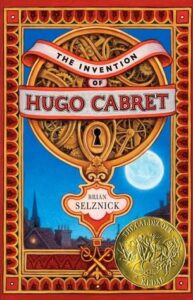 Author: Brian Selznick
Author: Brian Selznick
Illustrator: Brian Selznick
© Date: 2007
Publisher: Scholastic Press
Pages: 533
Chapters: Yes
Illustrations: Yes, many pages are just illustrations
Publisher Recommended Age: 9-12 years
Bonus Activities at End of Book: No, just some credits
Summary from Book: Orphan, clock keeper, and thief, Hugo lives in the walls of a busy Paris train station, where his survival depends on secrets and anonymity. But when his world suddenly interlocks—like the gears of the clocks that he keeps—with an eccentric, bookish girl and a bitter old man who runs a toy booth in the train station, Hugo’s undercover life and his most precious secret are put in jeopardy. A cryptic drawing, a treasured notebook, a stolen key, a mechanical man, and a hidden message from Hugo’s dead father form the backbone of this intricate, tender, and spellbinding mystery.
With 284 pages of original drawings, and combining elements of picture book, graphic novel, and film, Brian Selznick breaks open the novel form to create an entirely new reading experience. Here is a stunning, cinematic tour de force from a boldly innovative storyteller, artist, and bookmaker.

Page Pig Thoughts: When I read the description for this one, I did not think that I would really enjoy it. I am so happy that I gave it a try anyway. The combination of beautiful pictures and words made an incredible experience. The mystery is slowly unveiled piece by piece to keep you wondering what will happen. History is woven into the story, which makes the story even more intriguing. I absolutely loved this one and will be reading another Brian Selznick sooner rather than later.
As a potential item of interest, I had read Action! How Movies Began by Meghan McCarthy (a good read) shortly before this one. Having the movie background helped me pick out some of the movie history bits that were woven into Hugo Cabret. While you don’t have to read the two together, it may be a useful supplementary material.
Use caution with younger or sensitive readers: the fire killing Hugo’s father, orphan living, thieving of items, and a dead body being found at the bottom of a river may not be suitable.
Family Unit:
- Hugo (12 years old) lives on his own secretly in the train station apartments. He lived with his father until his father died in a museum fire. He lived with his uncle in the train station until his uncle disappeared.
- Isabelle lives with Georges and his wife, Jeanne, after her parents died in a car accident.
Conflict/Social Issues:
- Hugo is trying to survive secretly on his own. He does not have money to pay for basic needs, so he winds up stealing things even though he doesn’t want to.
- Hugo’s prized possession is his father’s notebook on the automaton and he desperately wants to get it back from the old man at the toy shop.
- Georges misses making films and is sad about losing his movie business. When he used his money to buy the toy booth, he makes a vow not to talk about his past anymore.
Positive Items:
- Having the pictures may help a reluctant reader to pick up a large book. Some pages only have one or two sentences.
- Seeing how magician skills translated into movies and mechanical knowledge helps with clocks and robots helps see how some life skills translate to other areas.
- Honesty works out better for the characters than secrets.
- Experiencing a different book format demonstrates that new ideas can be developed.
- Realizing picture books don’t have to just be for little kids.
Items of Interest:
- Hugo has his family’s knack for clocks and mechanical things.
- After Hugo’s father died, his uncle came to take him in. His uncle was an alcoholic and started disappearing for longer and longer amounts of time. One day, his uncle didn’t return.
- Hugo kept maintaining all of the clocks in the train station and collected his uncle’s paychecks so no one knew that his uncle was gone.
- Hugo could not cash the checks, so he did not have money. He stole food and things around the train station that he needed to survive.
- Hugo’s father had found an automaton robot in the museum. Hugo’s father had been working on repairing it so that it would work again. Hugo found the pieces of it in the rubble of the museum fire and worked to repair it on his own.
- Hugo gets caught stealing toys at the train station. The toy shop owner was a grumpy old man that reluctantly allowed Hugo to work around the shop to repay the man for what he had stolen. In exchange, the old man would give Hugo back his precious notebook.
- Hugo meets Isabelle. When she hears about the notebook, she steals it back for Hugo.
- Hugo was going to steal a book from the bookstore at the train station, but Isabelle’s friend, Etienne, gives him the money to buy the book.
- Etienne gets fired from his job at the movie theater because he was caught sneaking children in the back door.
- Georges’s wife, Jeanne, tries to prevent Isabelle and Hugo from talking with Georges about his past. She says that he has a fever and is sick. He winds up making a turnaround.
- Hugo has a dream about an accident at the train station (36 years earlier) when the brakes failed on train. The train barreled across the floor of the station and flew out the window.
- The old man from the toy shop turns out to be Georges Méliès, a magician and filmmaker. After the war, Georges could not make movies anymore. He was forced to sell his old movies to a company that melted down the film to make shoe heels. He was haunted by the sound of shoes clicking and depressed about giving up movies.
- Hugo goes back to the train station to get the automaton to take to Georges. Hugo gets caught by the Station Inspector and is put in the train station jail for stealing things around the station.
- Hugo’s Uncle’s body is found at the bottom of the Seine River where it had been for 3 months or so.
- Georges stands up for Hugo to get him out of the train station prison. Georges then takes Hugo to live in his home.
